Vintage Treasures: Nebula Award-Winning Novellas edited by Martin H. Greenberg
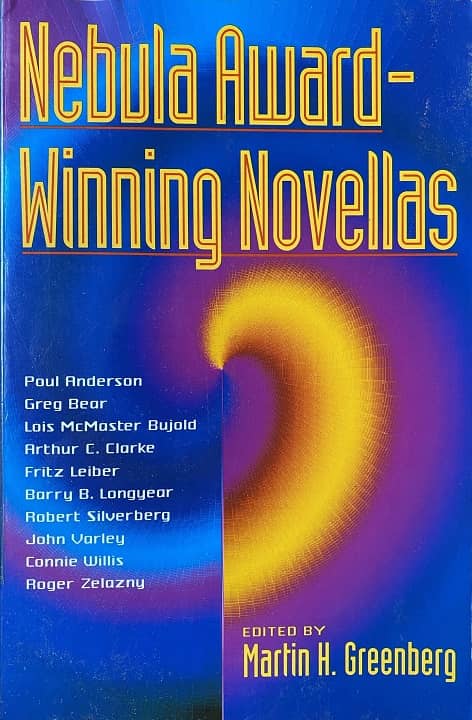 |
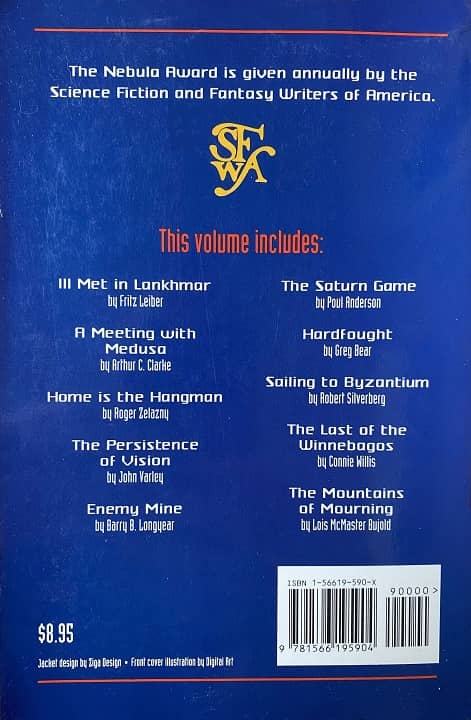 |
Nebula Award-Winning Novellas (Barnes & Noble, 1994)
It’s become fairly routine for the Nebula Awards Showcase, the annual anthology gathering the Science Fiction Writers of America’s Nebula award winning fiction, to omit the Best Novella. In fact, in the last five years only one novella, Martha Wells’s Murberbot tale All Systems Red, has been included in its entirety. Most of the others have been represented by brief extracts.
This isn’t a new problem. In his introduction to Nebula Award-Winning Novellas, B&N buyer Stephen Pagel complained that novellas, beloved by readers and writers alike, get no love from publishers and editors. Here’s his take.
I’ve had the opportunity to talk to many science fiction and fantasy fans. During our conversations, one complaint echoes over and over. Why isn’t there a good anthology of novella-length science fiction stories? Readers were able to find science fiction short story collections and novels, but novellas were extremely scarce — most were out-of-print or going out-of-print.
Once a story of novella-length makes its appearance in a magazine, it often disappears without a trace. Even Nebula award-winning novellas (unless they are recent winners) are virtually impossible to obtain. It is alarming to discover that works which are considered benchmarks in the genre can so easily vanish and not be enjoyed by future readers.
Perhaps to correct this perceived injustice, SFWA commissioned this anthology in 1994. Assembled by uber-editor Marty Greenberg, Nebula Award-Winning Novellas contains ten long novellas, averaging nearly 60 pages each (total length for all ten: 590 pages). They include perhaps the most famous Fafhrd and the Gray Mouser tale by Fritz Leiber, “Ill Met in Lankhmar,” a Technic History story by Poul Anderson, “The Saturn Game,” and a Miles Vorkosigan adventure by Lois McMaster Bujold, “The Mountains of Mourning.”
I was familiar with the earlier tales, including the Leiber, Clarke, and Varley, but not so much with some of the newer ones. Here’s John Clute at the Science Fiction Encyclopedia on Greg Bear’s “Hardfought.”
Another significant story from this period is “Hardfought” (February 1983 Asimov’s), whose depiction of a far-future spacefaring human civilization has a cognitive and linguistic density rarely found in sf; it also won a Nebula… [it depicts] with some confidence venues created by a human civilization faced with the need to balance ancient moral imperatives against a nearly infinite capacity to transform the universe.
“Hardfought” has multiple 5-star reviews at Goodreads; here’s my favorite, from reader Daniel.
Greg Bear packs an epic Space Opera full of ideas and spanning entire millennia into short novel length, without requiring several phonebook-sized volumes to blow your mind. The far-future depicted is intriguingly strange, the space battles against unknowable ancient aliens are intense and imaginative, but the most memorable part is the dread the reader feels as humanity, warped by the pressures of war, progressively becomes as alien and unrecognizable as the creatures it fights.
We now pause for a brief interlude to showcase a handful of other Nebula anthologies over the decades worthy of your attention.
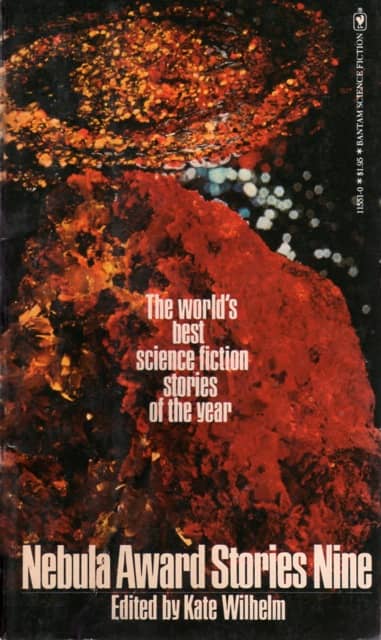 |
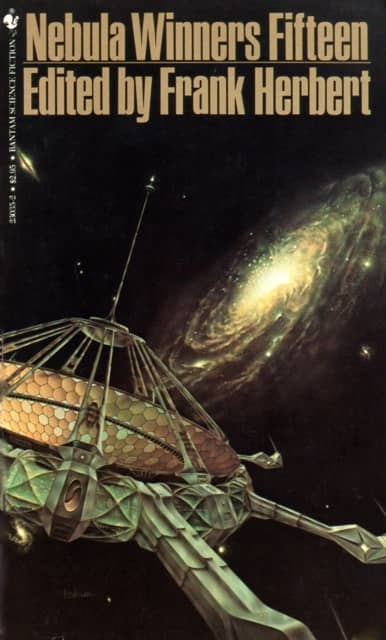 |
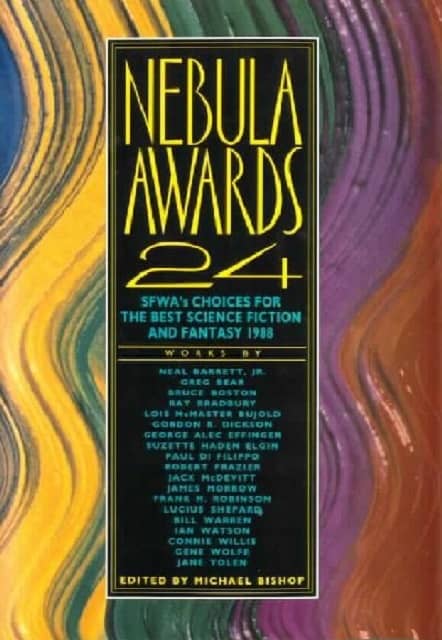 |
Nebula Award Stories Nine, Fifteen, and 24. Edited by Kate Wilhelm, Frank Herbert, and Michael Bishop
(Bantam Books, 1978 and 1983; Harcourt Brace Jovanovich, 1990). Covers by unknown, Gary LaSasso, and Michael Stuckey
Robert Silverberg’s “Sailing to Byzantium” beat out some very stiff competition for the Nebula in 1985 (including “24 Views of Mt. Fuji, by Hokusai” by Roger Zelazny, “Green Mars” by Kim Stanley Robinson, and “The Only Neat Thing to Do” by James Tiptree, Jr.) Jesse Huds has a fine review at Speculiction.
In the spirit of Thoreau and Emerson, William Butler Yeats’ 1928 poem “Sailing to Byzantium” discusses the desire for transcendence — putting aside the mortal cowl for immortality in a Grecian idyll. Grasping the sci-fi potential oozing from this concept, Robert Silverberg took the poem and developed it into an eponymous novella the genre community can be proud of…
It is the 50th century and humanity has evolved to lack for nothing. A Brave New World societal structure set in far future the main character, Charles Phillips, freely wanders the Five Cities of post-scarcity Earth on permanent holiday with his girlfriend, Gioia… Phillips and Gioia are in Alexandria, wandering the rebuilt, ancient city. Proud centaurs and sphinxes walk the streets, there is no crime or money, and the seventh wonder of the world — the lighthouse of Alexandria — stands over all, a symbol of the glory and power of humanity’s control of life.
But yet, not all is perfect in Eden; Phillips does not look like the other humans. He knows he is somehow a product of the 20th century, but lacks the knowledge how he came to the 50th. And likewise Gioia, despite her physical beauty, seems to be fading. Her colleagues remaining infinitely young and beautiful, a slow change is coming over the woman for reasons she hides to herself. Discovering his past while getting at the heart of Gioia’s ageing becomes Phillips mission. What the two discover together, well, Yeats’ poem serves as an excellent hint…
With the world as stage, Silverberg has plenty of room for thematic discussion, all captured well in character and story… “Sailing to Byzantium” is a simple yet beautiful sci-fi story of human proportion.
Here’s the complete Table of Contents.
Foreword by Stephen Pagel
Introduction by Pamela Sargent
“Ill Met in Lankhmar” by Fritz Leiber (The Magazine of Fantasy and Science Fiction, April 1970)
“A Meeting with Medusa” by Arthur C. Clarke (Playboy, December 1971)
“Home Is the Hangman” by Roger Zelazny (Analog Science Fiction/Science Fact, November 1975)
“The Persistence of Vision” by John Varley (The Magazine of Fantasy and Science Fiction, March 1978)
“Enemy Mine” by Barry B. Longyear (Isaac Asimov’s Science Fiction Magazine, September 1979)
“The Saturn Game” by Poul Anderson (Analog Science Fiction/Science Fact, February 2, 1981)
“Hardfought” by Greg Bear (Isaac Asimov’s Science Fiction Magazine, February 1983)
“Sailing to Byzantium” by Robert Silverberg (Isaac Asimov’s Science Fiction Magazine, February 1985)
“The Last of the Winnebagos” by Connie Willis (Isaac Asimov’s Science Fiction Magazine, July 1988)
“The Mountains of Mourning” by Lois McMaster Bujold (Analog Science Fiction and Fact, May 1989)
Nebula Award-Winning Novellas was published by Barnes & Noble Books in 1994. It is 603 pages (including Foreword and Introduction), priced at $8.95. It has been out of print since 1996, and there is no digital edition.
See all our recent Vintage Treasures here.
Good solid collection. My favs being the Leiber, Varley, Silverberg and Bear. The only one I have not read is the Bujold, a writer I don’t care for.
I wish they’d do an update of this book. 28 novellas have won Nebulas since this book was published…. that’s enough to fill three more big volumes!
Thanks for this reminder–as B&N books are instant remainders (some of the last of that vanishing breed), they don’t get much in the way of review, and didn’t back in the day pop up in too many competitor chainstores nor independents, though of course used copies in secondhand stores was a different matter. A lot of good anthologies (if, sadly, often not on the best paper) in that realm of publishing. Aside from brief programs such as the Tor Doubles, trying to find a latter-day Ace Double audience, novella often have had to wait for the authors’ own collections…or, recently, Tor.com among some of the busier small presses.
An sfnal typo: you cite publication date in 2994…good news, one hopes, for B&N and book publishing, but expensive to ship back through time.